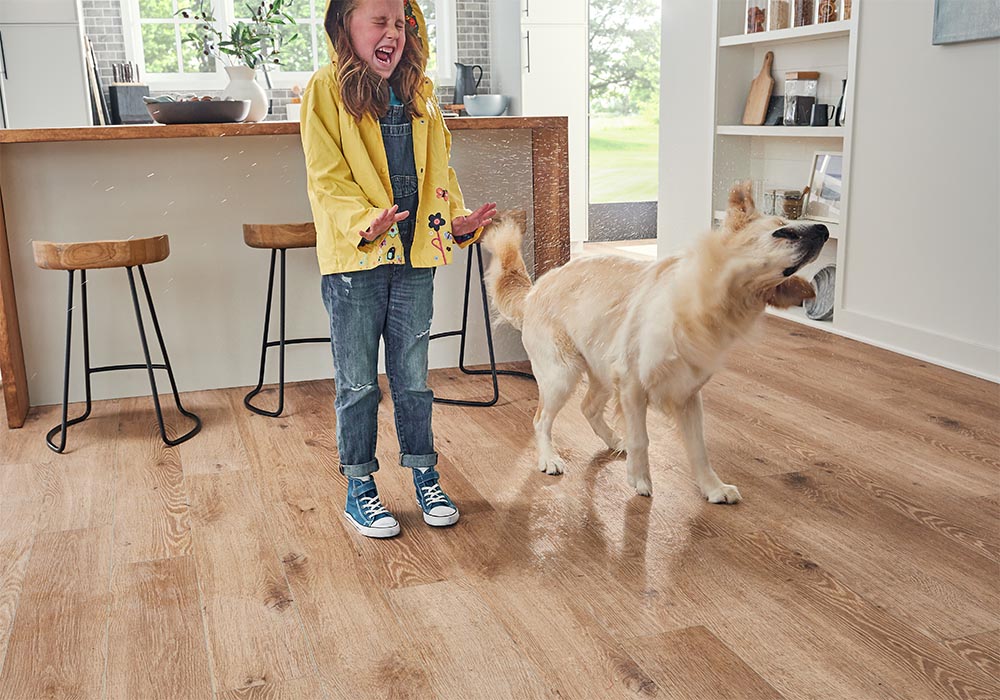Luxury Vinyl Plank vs. Laminate: What’s Right for Your Home?
Comparing two popular choices—and why LVP may be the better fit for modern living.
When it comes to upgrading your floors, you want something that not only looks beautiful but also fits your lifestyle. At Color Tile & Carpet of Salem, we help homeowners across the Willamette Valley find flooring that perfectly balances comfort, style, and functionality.
We are commonly asked about two options: Luxury Vinyl Plank (LVP) and laminate flooring. Both are great in their own ways, but if we had to crown a champion, LVP would stand just a little taller. Let’s break it down and help you determine which one’s right for your home.
This guide will help you compare each option from appearance and durability to moisture resistance and cost so you can feel confident about what’s going underfoot.
Appearance & Design Realism
If you’re going for that natural wood look, LVP and laminate both offer convincing visuals, but there are some key differences. Thanks to advanced printing technology and textured finishes, LVP is known for its ultra-realistic appearance. Many LVP products are embossed to match the grain of real wood, adding depth and authenticity that’s hard to beat. It even comes in stone-look styles, perfect for bathrooms and entryways.
Laminate has also advanced in terms of design. You’ll find wood-look patterns, varying tones, and textures, but laminate can sometimes have a shinier, more synthetic finish. The patterns also repeat more frequently, making the flooring appear less natural over large areas.
In short, if you want floors that look like the real deal, LVP usually has the edge.
Durability & Resistance to Wear
LVP and laminate are considered durable options, and either can handle a busy household’s daily hustle and bustle. However, LVP is a bit more forgiving. It’s softer and more flexible, which allows it to resist dents and impacts better than laminate. Its layered construction and protective wear layer make it great for high-traffic areas, active kids, and even pets zooming around.
On the other hand, laminate has a rigid core that can hold up well against scratches but may be more prone to chipping around the edges if furniture or other heavy objects are dragged across it. In terms of durability, LVP tends to last longer in homes where the flooring takes a lot of abuse.
If long-term performance is a top priority, LVP is often the better investment.
Moisture & Water Resistance
LVP excels in water resistance. It is 100% waterproof and can withstand muddy footprints, spilled juice, or a leaky washer without warping or swelling. That makes it ideal for bathrooms, kitchens, mudrooms, and basements; essentially any area where moisture is a concern.
Laminate has improved in water resistance over the years, but it’s still not waterproof. Once moisture seeps into the seams or beneath the surface, it can cause the material to swell and buckle. Laminate flooring requires more caution and maintenance in rooms where spills and splashes are common.
If you’re looking for a worry-free option—especially for families with kids or pets—LVP is hands down the better choice when water is involved.

Comfort Underfoot & Sound Control
Flooring isn’t just about how it looks—it’s about how it feels. LVP has a softer, cushioned surface, especially when it comes with an attached pad or is installed with quality underlayment. It’s a great option if you’re standing for long periods (hello, kitchen cooks!) or have little ones learning to walk.
It’s also much quieter. Laminate flooring tends to have a hollow, clicking sound when walked on, which can be a concern in multi-level homes or apartments. It is often installed as a floating floor, which can amplify sound. However, you can reduce the sound by pairing it with a sound-dampening underlayment or subfloor.
Overall, if comfort and a quieter home environment are on your checklist, LVP brings a noticeable upgrade.
Installation Flexibility
Both laminate and LVP are DIY-friendly and usually easy to install, but there are some differences. LVP is incredibly versatile and can be installed in varying ways (floating floor with a click-lock system, glued down, or even laid loose in some cases). It’s also more forgiving of minor imperfections in the subfloor and can often be installed directly over existing flooring, including tile.
Laminate also usually comes in a click-lock format, but its rigid structure means the subfloor needs to be completely level. Any uneven spots could cause issues with fit and performance.
While both are doable for handy homeowners, LVP makes the job easier and works in more types of spaces, which gives it a clear advantage in terms of flexibility.
Upfront Cost vs. Long-Term Value
If you’re looking strictly at upfront cost, laminate is slightly more affordable per square foot. That can make it a good option for short-term projects, rental properties, or rooms that don’t get much wear.
However, LVP delivers better value in the long run. Its durability, waterproofing, and low maintenance requirements mean you’re less likely to need repairs or replacement down the line. Over time, those savings add up.
Think of LVP as an investment in peace of mind—it may cost a bit more initially, but it often pays for itself in terms of convenience and lifespan.
Ease of Cleaning & Maintenance
We all want flooring that looks amazing without requiring a ton of upkeep. LVP makes it simple. Just sweep and occasionally mop with a damp cloth or mild cleaner. It’s resistant to stains, scuffs, and spills. It also requires no special treatments or complicated products.
Laminate needs a little more care. To prevent damage, avoid wet mops (damp is ok) and clean up spills quickly. It’s also best to use a cleaner specifically formulated for laminate to avoid dulling the finish.
Bottom line? LVP is lower maintenance and more forgiving, making it ideal for households that don’t want to fuss over floors.
So When Is Laminate the Better Choice?
Laminate flooring still has its place, especially if you’re working with a tight budget and moisture isn’t a concern. It can be a smart pick for bedrooms, home offices, or other low-traffic areas where comfort and water resistance are less critical. If you love the look and want a cost-effective solution, laminate might be the right choice for that space.
Just be sure to pair it with quality underlayment and keep an eye on moisture levels in the room.

Why We Recommend LVP at Color Tile & Carpet of Salem
At Color Tile, we’ve worked with almost every type of flooring. While there’s no one-size-fits-all solution, we’ve consistently seen Luxury Vinyl Plank flooring outperform laminate in the areas that matter most to homeowners: durability, water resistance, comfort, and maintenance.
It offers the rich look of hardwood with far fewer limitations, and it works well in virtually every room of the home. Whether you’re raising toddlers, welcoming grandkids, or just want floors that can handle your everyday life without stress, LVP is a versatile and reliable choice.
See the Difference for Yourself
Still unsure? Let us help you decide with a FREE in-home consultation. We’ll bring samples right to your door so you can see how LVP and laminate flooring look in your space with your lighting and décor. You can also test products instantly with our Perfect Home Virtual Flooring Assistant. There is no pressure, just helpful guidance from your local Salem flooring experts.
Visit us at 1110 Lancaster Dr. NE or book your free estimate online. From our door to your floor, we’re here to make your flooring upgrade smooth, stylish, and stress-free.










